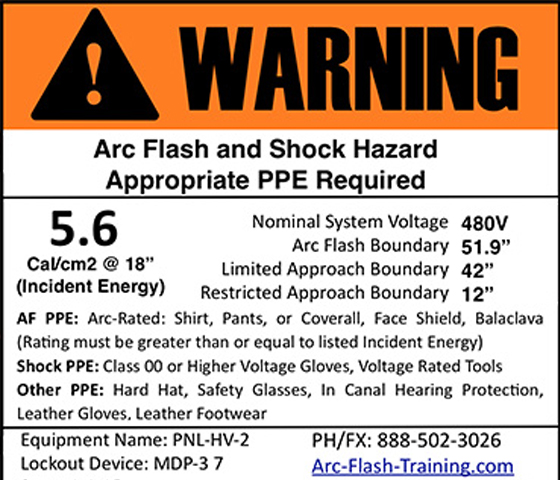IEEE 1584 Arc Flash Calculations
The Institute of Electrical and Electronics Engineers (IEEE) published the IEEE 1584 “Guide to Performing Arc Flash Calculations” to provide formulas and methods for calculating arc flash values in the workplace. The document provides empirical formulas for determining arc flash values known as incident energy, and arc flash boundaries. The range of the model used ranges from 208V to 15kV, and system fault currents of 700A to 106,000A. Theoretical models from Ralph Lees original paper are used for system conditions outside of the IEEE 1584 ranges. IEEE 1584 details a nine-step process for gathering information and calculating arc flash hazards.

Step 1: Collect The System And Installation Data
The largest effort in an arc-flash hazard study is collecting the field data. Even for a plant with nominally up-to-date single-line diagrams, time-current curves, and short-circuit study on a computer, the field part of the study will take about half of the effort. Regular site employees who are familiar with the site and its safety practices may be able to do this part of the job best.
While the data required for this study is similar to data collected for typical short-circuit and protective- device coordination studies, it goes further in that all low-voltage distribution and control equipment plus its feeders and large branch circuits must be included.
Step 2: Determine The System Modes Of Operation
In a site with a simple radial distribution system there is only one mode of operation—normal—but a more complex system can have many modes. Examples of modes include:
- One or more utility feeders in service.
- Utility interface substation secondary bus tie breaker open or closed.
- Generators running in parallel with the utility supply or in standby. t is important to determine the available short-circuit current for modes of operation that provide both the maximum and the minimum available short-circuit currents.
- Unit substation with two transformers with secondary tie opened or closed.
- MCC with one or two feeders, one or both energized.
- Unit substation with one or two primary feeders.
Step 3: Determine The Bolted Fault Currents
Input all data from the single-line diagrams and the data collection effort into a short circuit program. Commercially available programs can run thousands of buses and allow easy switching between modes. The simplified calculator included with this standard can determine bolted fault currents for radial systems for up to 600 V (see Figure B.1). Find the symmetrical root-mean-square (RMS) bolted fault current and X/R ratio at each point of concern—all locations where people could be working—by making each of these points a bus. Not every bus needs to be run for every mode because some modes will not significantly impact bolted fault current at some buses. For example, connecting transformer secondaries together may not increase fault energy on the primary side.
It is important to include all cables because to err on the high side does not necessarily increase safety: it may reduce it. Lower fault currents often persist longer than higher currents as shown on protective-device time-current curves.
Step 4: Determine The Arc Fault Currents
The arc fault current at the point of concern and the portion of that current passing through the first upstream protective device must be found.
The arc fault current depends primarily on the bolted fault current. The bolted fault current in the protective device can be found from the short-circuit study by looking at a one-bus-away run. This will separate fault contributions from normal feeder, alternate feeder, and downstream motors.
The arc fault currents can then be calculated. The calculated arc fault current will be lower than the bolted fault current due to arc impedance, especially for applications under 1000 V. For medium voltage applications, the arc current is still a bit lower than the bolted fault current, and it must be calculated. The equations shown in 5.2 are incorporated in the programs offered with this standard.
The current that flows through an arcing fault is usually significantly less than the bolted fault current, due to greater resistance. Arc fault current calculations are based on voltage, bolted fault current, conductor gap distance, and other factors. IEEE 1584 presents two formulas for calculating arc fault currents, one for use with 0.208-1 kV systems, and the other for systems between 1 and 15 kV.
For systems between 0.208 and 1 kV:
lg Ia = K + 0.662(lg Ibf) + 0.0966(V) + 0.000526(G) + 0.5588(V)(lg Ibf) – 0.00304(G)(lg Ibf)
For systems between 1 and 15 kV:
lg Ia = 0.00402 + 0.983(lg Ibf)
where Ia = arc fault current in kA; K = –0.153 for open-air arcs and –0.097 for enclosed arcs; Ibf = 3-phase bolted fault current in kA; V = voltage in kV; G = conductor gap in mm.
5. Determine Protective Device Characteristics And Duration Of Arcs
The time-current curves of upstream protective devices are the major factor in determining how long an arc-fault will last. An effort should be made to determine the actual settings rather than relying on standard values, as these may cause incident energy to vary greatly.
Another consideration when analyzing protective devices is that incident energy depends on both fault current and time. Since protective devices are slower at lower currents, minimum fault currents often pose the worst-case arc flash scenario.
In the field survey up-to-date system time-current curves may have been found. If not, it is best to create them—commercially available software makes this task easy. Alternatively, for a very simple study, it is possible to use protective device characteristics, which can be found in manufacturer’s data.
For fuses, the manufacturer’s time-current curves may include both melting and clearing time. If so, use the clearing time. If they show only the average melt time, add to that time 15%, up to 0.03 seconds, and 10% above 0.03 seconds to determine total clearing time. If the arcing fault current is above the total clearing time at the bottom of the curve (0.01 seconds), use 0.01 seconds for the time.
For circuit breakers with integral trip units, the manufacturer’s time-current curves include both tripping time and clearing time.
For relay operated circuit breakers, the relay curves show only the relay operating time in the time-delay region. For relays operating in their instantaneous region, allow 16 milliseconds on 60 Hz systems for operation. The circuit breaker opening time must be added. Table 1 shows recommended circuit breaker operating times. Opening times for particular circuit breakers can be verified by consulting the manufacturer’s literature.
Step 6: Document The System Votages And Classes Of Equipment
For each bus, document the system voltage and the class of equipment as shown in Table 2 of the IEEE 1584. This will allow application of equations based on standard classes of equipment and bus-to-bus gaps as shown in Table 2 of the IEEE 1584.
Step 7: Select The Working Distances
Arc-flash protection is always based on the incident energy level on the person’s face and body at the working distance, not the incident energy on the hands or arms. The degree of injury in a burn depends on the percentage of a person’s skin that is burned. The head and body are a large percentage of total skin surface area and injury to these areas is much more life threatening than burns on the extremities. Typical working distances are shown in Table 3 of the IEEE 1584.
Step 8: Determine The Incident Energy For All Equipment
A software program for calculating incident energy must be selected. Clause 6 identifies and discusses the two calculators included with this guide and possible future commercial products. In each case the equations in the models, which appear in Clause 5, are embedded in the program or worksheet. In some programs the problem is solved one bus at a time; with others, hundreds or thousands of buses can be solved simultaneously.
Incident energy is defined in NFPA 70E as “the amount of energy impressed on a surface, a certain distance from the source, generated during an electrical arc event.” In an arc flash hazard study, the “surface” is the worker’s body at the assumed working distance. Incident energy is expressed in calories/cm2. IEEE 1584 uses the following formulas:
(1) E = 4.184(Cf)(En)(t/0.2)(610x/Dx)
where E = incident energy in joules/cm2; Cf is a calculation factor (1.0 for voltages above 1 kV, and 1.5 for voltages below 1 kV); En = normalized incident energy (from equation (2) below); t = arc duration in seconds;D = distance from arc in mm; x = distance exponent (see table below)
(2) lg En = K1 + K2 + 1.081(lg Ia) + 0.0011(G)
where En = energy normalized for distance of 610 mm and arc duration of 0.2 seconds, in joules/cm2; K1 = –0.792 for open-air arcs and –0.555 for enclosed arcs; K2 = 0 for ungrounded/high-Z systems and –0.113 for grounded systems; G = arc gap in mm; Ia = predicted 3-phase arc fault current in kA
Step 9: Determine The Flash-Protection Boundary FOr All Equipment
To find the flash-protection boundary, the equations for finding incident energy can be solved for the distance from the arc source at which the onset of a second degree burn could occur. The incident energy must be set at the minimum energy beyond which a second degree burn could occur. The programs include the flash-protection boundary based on an incident energy of 5.0 J/cm2. 11
The FPB is the distance at which incident energy is 1.2 cal/cm2, which is the amount of heat needed to cause second-degree burns. The IEEE formula for calculating FPB is:
DB = [4.184(Cf)(En)(t/0.2)(610x/EB)]1/x
where EB is the desired incident energy at the boundary (usually 1.2 cal/cm2, but occasionally set at a value matching proposed PPE rating), with other variables defined as for the incident energy equations above.
Specialization
EDS specializes in many different aspects of electrical training and engineering.
Affordable Price
All training courses are available in affordable prices.
Free Estimation
To get a free no obligation quote, please email us your details or call us and we will get back to you the same day.
